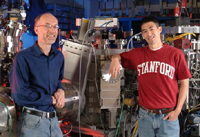However, Orbitronics may maintain investments in silicon technology even after today's technology reaches its limits
Avi Blizovsky

IBM lab at Stanford
Direct link to this page: https://www.hayadan.org.il/orbitroics0805.html
For about forty years, the semiconductor industry has been able to steadily shrink the electronic components on a silicon chip, providing much more performance for computers. Now, the basic laws of physics limit the development and this requires the industry to carry out research to find alternatives. In an article published August 1 in the online version of the journal Physical Review Letters (PRL), physicists at Stanford University presented "orbittronics," an alternative to conventional electronics that may one day allow scientists to bypass this daunting limit and still use the cheap and familiar silicon. "Today's chip miniaturization is limited because of the scattering of light," says Shoucheng Zhang, a professor of physics, applied physics and, incidentally, also an electronics engineer, who co-wrote the article in PRL. "Up to 40 percent of the electrical power in circuits is lost due to heat leakage, which makes miniaturization an impossible task.
"Spintronics"
In recent years, research to find alternatives to current semiconductors has culminated in the discovery of a nanotechnology called "spintronics", which uses the electron's "spin" property to produce an innovative type of current that integrated circuits can process as information. The spin refers to the way the electron rotates on its axis, similar to the rotation of the Earth. In 2003, Zhang and his colleagues at the University of Tokyo showed that the production and handling of a stream of ordered electron spins within an electric field would not cause any loss through heat - a technique called spintronics. Zhang now serves as co-director of the IBM Spintronics Science and Application Center at Stanford, together with Prof. James Harris (Harris) from Stanford and a fellow researcher from IBM named Stuart Parkin (Parkin). The center, founded in 2004, conducts research in many applications of spintronics, including superconductivity at room temperature and quantum computing.
play angels
Despite all its potential, the economy of spintronics is that it does not work with lighter atoms such as silicon (silicon), which is preferred by the microelectronics industry. In an introduction to Zhang's new research in a paper in PRL, he and doctoral students Andre Bernoig and Taylor Hughes showed how, in theory, silicon could use a nearby technology they call orbittronics. By using orbittronics, Zhang said, chipmakers will be able to take advantage of spintronics without abandoning silicon. Both orbitronics and spintronics involve a physical property called angular momentum, a property that exists in any mass moving around a fixed point, be it a sphere or an electron.
Like an electric current created by the flow of negatively charged electrons in the conventional integrated circuits of ours, the rotary current will consist of the flow of electrons together with their respective angular momentum in the orbitronic circuit. "If you push the electrons forward in an electric field, the orbital current will be perpendicular to that electric current." Zhang said. "It will not carry a charge, but the peripheral angular momentum perpendicular to the direction in which the electrons are moving. Thus, he explains, using orbittronics, the silicon will still provide a useful current without losing heat at room temperature. Some alternative technologies require cold temperatures that are difficult to operate and expensive to maintain.” added
"From theory to application"
The researchers pointed out that orbittronics still needs to go through a long development before it becomes an applied technology in the semiconductor industry. "It's so new," Zhang said. "When something is discovered for the first time, it's hard to say how many more difficulties will be piled up on the way to the practical world." added Harris agrees with him. None of the promises of spintronics will be fulfilled for at least the next decade until the technology becomes a mature commercial technology. It's not going to happen right away, even if we've been able to go through the steps so far." said.
However, if Orbitronics proves to be economically viable as a production technology, this will be an advantage for the industry to be able to stay with silicon." Zhang said. "There are huge investments in silicon production." said. "We won't be able to change overnight to a new material."
. "
to a Stanford University press release
https://www.hayadan.org.il/BuildaGate4/general2/data_card.php?Cat=~~~233206195~~~80&SiteName=hayadan
